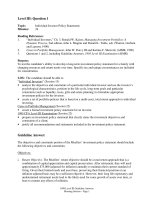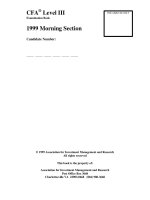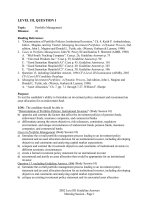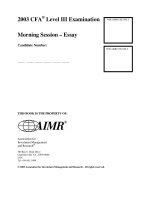L3 mock sample exam CFA level III essay questions 2001
Bạn đang xem bản rút gọn của tài liệu. Xem và tải ngay bản đầy đủ của tài liệu tại đây (193.27 KB, 36 trang )
2001 CFA® Level III Examination
FOR AIMR USE ONLY
Morning Section - Essay
Candidate Number:
FOR AIMR USE ONLY
_____ _____ _____ _____ _____ _____
THIS BOOK IS THE PROPERTY OF:
Association for
Investment Management
and Research
Post Office Box 3668
Charlottesville VA 22903-0668
USA
Tel: 804-951-5499
© 2001 Association for Investment Management and Research. All rights reserved.
The following list contains the command words used on the Morning Section of
the 2001 Level III examination. Candidates may want to refer to this list as they
formulate their answers.
Critique:
To offer a critical review or commentary.
Describe:
To transmit a mental image, an impression, or an understanding of the nature
and characteristics of.
Determine:
To come to a decision as the result of investigation or reasoning; to settle or
decide by choice among alternatives or possibilities.
Discuss:
To discourse about through reasoning or argument; to present in detail.
Explain:
To give the meaning or significance of; to provide an understanding of; to give
the reason for or cause of.
Formulate:
To put into a systematized statement or expression; to prepare according to a
formula.
Give:
To yield or furnish as a product, consequence, or effect; to offer for the
consideration, acceptance, or use of another.
Indicate:
To point out or point to with more or less exactness; to show or make known
with a fair degree of certainty.
Judge:
To form an opinion about through careful weighing of evidence and testing of
premises.
Justify:
To prove or show to be valid, sound, or conforming to fact or reason; to
furnish grounds or evidence for.
Select:
To choose from a number or group – usually, by fitness, excellence, or other
distinguishing feature.
State:
To express in words.
The Morning Section of the 2001 CFA Level III Examination has 12 questions.
For grading purposes, the maximum point value for each question is equal to the
number of minutes allocated to that question.
Question
1
2
3
4
5
6
7
8
9
10
11
12
Topic
Portfolio Management
Portfolio Management
Portfolio Management
Portfolio Management
Portfolio Management
Portfolio Management
Portfolio Management
Portfolio Management
Portfolio Management
Portfolio Management
Asset Valuation
Asset Valuation
Total:
Minutes
28
9
10
18
15
6
20
12
23
12
9
18
180
Questions 1 through 5 relate to the pension plan of Acme Industries. A total of 80 minutes
is allocated to these questions. Candidates should answer these questions in the order
presented.
QUESTION 1 HAS TWO PARTS FOR A TOTAL OF 28 MINUTES.
Angus Walker, CFA, is reviewing the defined benefit pension plan of Acme Industries. Based in
London, Acme has operations in North America, Japan, and several European countries. Next
month, the retirement age for full benefits under the plan will be lowered from age 60 to age 55.
The median age of Acme’s workforce is 49 years. Walker is responsible for the pension plan’s
investment policy and strategic asset allocation decisions. The goals of the plan include
achieving a minimum expected return of 8.4 percent with expected standard deviation no greater
than 16.0 percent.
Walker is evaluating the current asset allocation (Exhibit 1-1) and selected financial information
for the company (Exhibit 1-2).
Exhibit 1-1
Acme Pension Plan
Current Asset Allocation
International
Equities (MSCI
World ex-U.K.)
10%
U.K. Small
Capitalization
Equities
13%
U.K. Large
Capitalization
Equities
30%
U.K. Bonds
42%
Cash
5%
Exhibit 1-2
Acme Industries
Selected Financial Information
(in millions)
Acme Industries Total Assets
Pension Plan Data:
Plan Assets
Plan Liabilities
£16,000
£6,040
£9,850
There is an ongoing debate within Acme Industries about the pension plan’s investment policy
statement (IPS). Two investment policy statements under consideration are shown in Exhibit 1-3.
Return Requirement
Exhibit 1-3
Investment Policy Statements
IPS X
IPS Y
Plan’s objective is to outperform Plan’s objective is to match the
the relevant benchmark return by relevant benchmark return.
a substantial margin.
Risk Tolerance
Plan has a high risk tolerance
because of the long-term nature
of the plan and its liabilities.
Plan has a low risk tolerance
because of its limited ability to
assume substantial risk.
Time Horizon
Plan has a very long time horizon
because of the plan’s infinite life.
Plan has a shorter time horizon
than in the past because of plan
demographics.
Liquidity
Plan needs moderate level of
liquidity to fund monthly benefit
payments.
Plan has minimal liquidity needs.
A.
Determine, for each of the following components, whether IPS X or IPS Y has the
appropriate language for the pension plan of Acme Industries. Justify each response
with one reason.
i.
ii.
iii.
iv.
Return Requirement
Risk Tolerance
Time Horizon
Liquidity
Note: Some components of IPS X may be appropriate, while other components of IPS Y
may be appropriate.
Answer Question 1-A in the Template provided on pages 5 and 6.
(16 minutes)
To assist Walker, Acme has hired two pension consultants, Lucy Graham and Robert Michael.
Graham believes that the pension fund must be invested to reflect a low risk tolerance, but
Michael believes the pension fund must be invested to achieve the highest possible returns. The
fund’s current asset allocation and the allocations recommended by Graham and Michael are
shown in Exhibit 1-4.
Exhibit 1-4
Asset Allocations
(in %)
U.K. Large Capitalization Equities
U.K. Small Capitalization Equities
International Equities (MSCI World ex-U.K.)
U.K. Bonds
Cash
Total
Expected Portfolio Return (%)
Expected Portfolio Volatility
(Standard Deviation in %)
B.
Current
30
13
10
42
5
100
Graham
20
8
10
52
10
100
Michael
40
20
18
17
5
100
9.1
16.1
8.2
12.8
10.6
21.1
Select which of the three asset allocations in Exhibit 1-4 is most appropriate for Acme’s
pension plan. Explain how your selection meets each of the following objectives or
constraints for the plan:
i.
ii.
iii.
Return Requirement
Risk Tolerance
Liquidity
(12 minutes)
Answer Question 1-B in the Template provided on page 8.
Template for Question 1-A
Determine
whether
IPS X or
Component
IPS Y has
appropriate
language
(Circle One)
IPS X
Return
Requirement
IPS Y
IPS X
Risk
Tolerance
IPS Y
Template continued on next page
Justify with one reason
Template for Question 1-A (continued)
Determine
whether
IPS X or
Component
IPS Y has
appropriate
language
(Circle One)
IPS X
Time Horizon
IPS Y
IPS X
Liquidity
IPS Y
Justify with one reason
Template for Question 1-B
Select which of the three asset allocations in Exhibit 1-4 is most appropriate for Acme’s
pension plan (Check One)
Current
Objective or
Constraint
Return
Requirement
Risk
Tolerance
Liquidity
Graham
Michael
Explain how your selection meets each of the following objectives or
constraints for the plan
QUESTION 2 HAS ONE PART FOR A TOTAL OF 9 MINUTES.
Michael has developed an economic forecast for presentation to the Board of Trustees of Acme’s
defined benefit pension plan. He projects that U.K. inflation will be substantially higher over the
next three years than the Board’s current forecast.
Michael recommends that the Board immediately take the following actions based on his
forecast:
1. Revise the investment policy statement of the pension plan to take into account a
change in the forecast for inflation in the U.K.
2. Reallocate pension assets from domestic (U.K.) to international equities because he
also expects inflation in the U.K. to be higher than in other countries.
3. Initiate a program to protect the financial strength of the pension plan from the effects
of U.K. inflation by indexing benefits paid by the plan.
State whether each recommended action is correct or incorrect. Justify each of your responses
with one reason.
Answer Question 2 in the Template provided on page 11.
(9 minutes)
Template for Question 2
State whether
each
recommended
Action
action is
Correct or
Incorrect
(Circle One)
1. Revise the
investment
policy statement
of the pension
plan to take into
account a
change in the
forecast for
inflation in the
U.K.
2. Reallocate
pension assets
from domestic
(U.K.) to
international
equities because
he also expects
inflation in the
U.K. to be
higher than in
other countries.
3. Initiate a
program to
protect the
financial
strength of the
pension plan
from the effects
of U.K.
inflation by
indexing
benefits paid by
the plan.
Correct
Incorrect
Correct
Incorrect
Correct
Incorrect
Justify with one reason
QUESTION 3 HAS TWO PARTS FOR A TOTAL OF 10 MINUTES.
Glenn Rose is an equity portfolio manager for Acme’s pension plan; the portfolio he manages for
Acme is currently invested 100 percent in domestic securities. The Board of Trustees has urged
Rose to investigate aggressively pursuing global investments. Rose is deciding whether or not to
add international equity securities to the portfolio.
Rose has identified an international emerging market and an international developed market for
possible investment. He is reviewing Exhibits 3-1 and 3-2, which contain forecasts of expected
5-year performance characteristics for the domestic market and the two international markets
under two different scenarios.
Rose has decided to pursue one of three possible investment strategies:
1. 100 percent domestic (his current portfolio)
2. 50 percent domestic market and 50 percent international developed market
3. 50 percent domestic market and 50 percent international emerging market
He has decided that he will not hedge any foreign exchange exposure.
Exhibit 3-1
Scenario I
Forecasted 5-Year Data
(in Domestic Currency)
Domestic International
Market
Emerging
Market
Expected Returns
22.9%
2.4%
Expected Standard Deviation
17.4%
17.3%
Expected Correlation Matrix
Domestic International
Market
Emerging
Market
Domestic Market
1.00
International Emerging Market
0.80
1.00
International Developed Market
0.84
0.73
International
Developed
Market
10.2%
17.1%
International
Developed
Market
1.00
Using only the information in Exhibit 3-1,
A.
Determine which one of the three strategies Rose should pursue if Scenario I is accurate.
Justify your response with two reasons. No calculations are required.
(5 minutes)
Exhibit 3-2
Scenario II
Forecasted 5-Year Data
(in Domestic Currency)
Domestic International
Market
Emerging
Market
Expected Returns
8.7%
8.4%
Expected Standard Deviation
14.3%
14.1%
Expected Correlation Matrix
Domestic International
Market
Emerging
Market
Domestic Market
1.00
International Emerging Market
0.33
1.00
International Developed Market
0.80
0.66
International
Developed
Market
8.4%
14.0%
International
Developed
Market
1.00
Using only the information in Exhibit 3-2,
B.
Determine which one of the three strategies Rose should pursue if Scenario II is
accurate. Justify your response with two reasons. No calculations are required.
(5 minutes)
QUESTION 4 HAS TWO PARTS FOR A TOTAL OF 18 MINUTES.
During the annual review of Acme’s pension plan, several Trustees questioned Graham about
various aspects of performance measurement and risk assessment.
In particular, one Trustee asked about the appropriateness of using each of the following
benchmarks:
•
•
•
A.
market index
benchmark normal portfolio
median of the manager universe
Explain two different weaknesses of using each of the three benchmarks to measure the
performance of a portfolio.
Note: Your response must contain a total of six different weaknesses.
Answer Question 4-A in the Template provided on pages 21 and 22.
(6 minutes)
Another Trustee asked how to distinguish among the following performance measures:
•
•
•
B.
i.
ii.
the Sharpe ratio
the Treynor measure
Jensen’s alpha
Describe how each of the three performance measures is calculated.
State whether each measure assumes that the relevant risk is systematic,
unsystematic, or total. Explain how each measure relates excess return and the
relevant risk.
(12 minutes)
Template for Question 4-A
Benchmark
Explain two different weaknesses of using each of the benchmarks to
measure the performance of a portfolio
Market index
1.
2.
Benchmark normal
portfolio
1.
2.
Template continued on next page
Template for Question 4-A (continued)
Benchmark
Explain two different weaknesses of using each of the benchmarks to
measure the performance of a portfolio
Median of the
1.
manager universe
2.
QUESTION 5 HAS TWO PARTS FOR A TOTAL OF 15 MINUTES.
Edmondson Capital Management is one of the investment managers for the Acme pension fund
portfolio. Edmondson is based in the U.K. and has prepared a draft Performance Report (Exhibit
5-1) about one of its products for distribution to current and potential clients.
Total Return
(%)
Year
1990
1991
1992
1993
1994
1995
1996
1997
1998
1999
2000
14.2
5.4
9.1
12.3
–3.4
8.9
11.2
7.1
–3.7
15.5
10.6
Exhibit 5-1
Edmondson Capital Management
Performance Results: Balanced Composite
January 1, 1990 through December 31, 2000
Benchmark
Number Composite Total Assets Percentage
Return
of
Dispersion
at End of
of Firm
(%)
Portfolios
(%)
Period
Assets
(%)
(£ millions)
12.0
2
6.5
75
15
6.1
5
5.3
180
17
8.2
7
4.7
275
21
10.4
8
3.9
412
22
–4.8
12
1.8
751
26
7.5
14
N.A.
1,120
29
10.5
17
3.5
1,266
31
6.2
22
1.9
1,453
33
–1.5
25
4.6
1,688
34
14.1
28
2.0
1,517
32
12.3
31
5.4
1,744
34
Total Firm
Assets
(£ millions)
500
1,058
1,310
1,873
2,888
3,862
4,084
4,403
4,965
4,741
5,129
Edmondson has prepared and presented this report in compliance with the Global Investment Performance Standards™
(GIPS™). Edmondson is an independent investment management firm that is not affiliated with any parent organization.
Independent Verifiers, Ltd. has reviewed the Performance Report in Exhibit 5-1 and has
recommended that the following notes, among others, should be included in a GIPS compliant
statement:
1. All balanced accounts over £1.0 million are included in the composite at the beginning of the
first full quarter under management.
2. The balanced composite is denominated in pounds (£) and asset-weighted as of the end of the
period.
3. The year 1995 is not in compliance with GIPS.
A.
State whether or not each of the Notes 1 through 3 meets the disclosure and calculation
requirements for a performance report to be GIPS compliant. Explain why each note
does or does not meet the disclosure and calculation requirements.
Answer Question 5-A in the Template provided on page 29.
(6 minutes)
Edmondson has now brought the year 1995 into compliance with GIPS and also claims
compliance with the AIMR Performance Presentation Standards™ (AIMR-PPS™). Edmondson
manages accounts for high net worth individuals. Several of Edmondson’s clients have special
instructions concerning the management of their assets. The managing directors of Edmondson
are uncertain about including these portfolios in Edmondson’s balanced composite.
B.
•
Client X has given Edmondson a portfolio of £25 million to manage. For tax reasons,
Client X has requested that Edmondson not realize any profits (capital gains) on
existing assets in the portfolio.
•
Client Y has given Edmondson a portfolio of £50 million to manage and instructed
Edmondson to overlay a tactical asset allocation strategy. This tactical asset
allocation portion now equals 25 percent of the total market value of the original
portfolio.
•
Client Z has given Edmondson a portfolio of £10 million with discretion to leverage
the account. The client restricts margin to 50 percent of the market value of the
portfolio. Edmondson subsequently leverages the account to £13 million.
Determine whether each of these client portfolios should be included in Edmondson’s
balanced composite to ensure that Edmondson’s performance presentation report is
prepared in compliance with AIMR-PPS. Justify each response with one reason.
Indicate, for each of the portfolios included, the pound (£) amount that should be
included in the composite calculation.
Answer Question 5-B in the Template provided on page 31.
(9 minutes)
Template for Question 5-A
State whether
each note
Explain why each note does or does not meet
Note
meets
requirements
requirements
(Circle One)
1. All balanced
accounts over
£1.0 million
are included
in the
composite at
the beginning
of the first full
quarter under
management.
2. The balanced
composite is
denominated
in pounds (£)
and assetweighted as of
the end of the
period.
3. The year 1995
is not in
compliance
with GIPS.
Yes
No
Yes
No
Yes
No
Template for Question 5-B
Determine
whether
client
Client
portfolio
should be
included
(Circle One)
Yes
X
No
Yes
Y
No
Yes
Z
No
Justify with one reason
Indicate
pound (£)
amount in
composite
(if included)
Questions 6 – 9 relate to James Stephenson. A total of 61 minutes is allocated to these
questions. Candidates should answer these questions in the order presented.
QUESTION 6 HAS ONE PART FOR A TOTAL OF 6 MINUTES.
James Stephenson has accumulated a substantial investment portfolio without any clear longterm strategy in mind. His current investment advisor recommends that he develop an
investment policy for his portfolio. Stephenson solicits advice from several friends with
experience in the financial markets. Their advice includes:
My investment firm, based on its experience with investors, has standard
policy statements in five categories. You would be better served to adopt
one of these standard policy statements instead of spending time
developing a policy based on your individual circumstances.
Developing a long-term policy can be unwise given the fluctuations of the
market. You want your investment advisor to react to changing conditions
and not be limited by a set policy.
Because your investment advisor will retire in the next year or two, it
would be inappropriate to commit to an investment policy before you
solicit the input of your new advisor.
State whether you agree or disagree with each of the above comments. Justify each of your
conclusions with one reason.
Answer Question 6 in the Template provided on page 35.
(6 minutes)
Template for Question 6
Comment
My investment firm, based
on its experience with
investors, has standard
policy statements in five
categories. You would be
better served to adopt one
of these standard policy
statements instead of
spending time developing
a policy based on your
individual circumstances.
Developing a long-term
policy can be unwise
given the fluctuations of
the market. You want your
investment advisor to
react to changing
conditions and not be
limited by a set policy.
Because your investment
advisor will retire in the
next year or two, it would
be inappropriate to
commit to an investment
policy before you solicit
the input of your new
advisor.
State
Agree or
Disagree
(Circle
One)
Agree
Disagree
Agree
Disagree
Agree
Disagree
Justify with one reason
QUESTION 7 HAS TWO PARTS FOR A TOTAL OF 20 MINUTES.
Stephenson, age 55 and single, is a surgeon. Stephenson has accumulated a $2.0 million
investment portfolio that has a large concentration in small capitalization U.S. equities. Over the
past five years, the portfolio has averaged 20 percent annual total return on investment.
His newly hired financial advisor, Caroline Coppa, has compiled the following notes from her
meetings with Stephenson:
Stephenson hopes that, over the long term, his investment portfolio will continue to earn
20 percent annually. For the remainder of this year, he would like to earn a return greater
than the 5 percent yield to maturity currently available from short-term government
notes. When asked about his risk tolerance, he described it as “average.” He was
surprised when informed that U.S. small cap portfolios have historically experienced
extremely high volatility.
He does not expect to retire before age 70. His current income is more than sufficient to
meet his expenses. Upon retirement, he plans to sell his surgical practice and use the
proceeds to purchase an annuity to cover his post-retirement cash flow needs. He could
not state any additional long-term goals or needs.
Both his income and realized capital gains are taxed at a 30 percent rate. No pertinent
legal or regulatory issues apply. He has no pension or retirement plan but does have
sufficient health insurance for post-retirement needs.
Stephenson asks Coppa to draft an investment policy statement based on their initial meetings.
A.
Formulate the following elements of Stephenson’s investment policy statement and
justify your response for each element with two arguments:
i.
ii.
Return Requirement
Risk Tolerance
(12 minutes)
B.
Formulate the following elements of Stephenson’s investment policy statement and
justify your response for each element with two arguments:
i.
ii.
Liquidity
Time Horizon
(8 minutes)
QUESTION 8 HAS ONE PART FOR A TOTAL OF 12 MINUTES.
Stephenson’s current portfolio of $2.0 million is invested as shown in Exhibit 8-1.
Exhibit 8-1
Summary of Stephenson’s Current Portfolio
Percent
Expected
Annual Standard
Value
of Total Annual Return
Deviation
Short Term Bonds
$200,000
10%
4.6%
1.6%
Domestic Large Cap Equities
$600,000
30%
12.4%
19.5%
Domestic Small Cap Equities
$1,200,000
60%
16.0%
29.9%
Total Portfolio
$2,000,000
100%
13.8%
23.1%
Stephenson soon expects to receive an additional $2.0 million and plans to invest the entire
amount in an index fund that best complements the current portfolio. Coppa is evaluating the four
index funds shown in Exhibit 8-2 for their ability to produce a portfolio that will meet the
following two criteria relative to the current portfolio:
•
•
maintain or enhance expected return
maintain or reduce volatility
Each fund is invested in an asset class that is not substantially represented in the current
portfolio.
Index Fund
Fund A
Fund B
Fund C
Fund D
Exhibit 8-2
Index Fund Characteristics
Expected
Expected Annual
Annual Return
Standard
Deviation
15%
25%
11%
22%
16%
25%
14%
22%
Correlation of Returns
with Current Portfolio
+0.80
+0.60
+0.90
+0.65
State which fund Coppa should recommend to Stephenson. Justify your choice by describing
how your chosen fund best meets both of Stephenson’s criteria. No calculations are required.
(12 minutes)
QUESTION 9 HAS TWO PARTS FOR A TOTAL OF 23 MINUTES.
Twenty years later, Stephenson is meeting with his new financial advisor, Jennifer Bolger.
Bolger is evaluating whether Stephenson’s investment policy remains appropriate for his
circumstances.
A.
•
Stephenson is now age 75 and retired. His spending requirements are expected to
increase with the rate of general inflation, which is expected to average 3.0 percent
annually.
•
Stephenson estimates his current expenses at $150,000 annually. An annuity,
purchased with the proceeds from the sale of his surgical practice, provides $20,000
of this amount. The annuity is adjusted for inflation annually using a national price
index.
•
Because of poor investment performance and a high level of spending, Stephenson’s
asset base has declined to $1,200,000 exclusive of the value of the annuity.
•
Stephenson sold all of his small-cap investments last year and invested the proceeds
in domestic bonds.
•
Because his past international equity investments have performed poorly, Stephenson
has serious doubts about whether his portfolio should contain international equities.
•
Stephenson plans to donate $50,000 to a charity in three months.
Discuss how each of the following components of Stephenson’s investment policy
statement should now reflect the changes in his circumstances.
i.
ii.
iii.
iv.
Return Objective
Risk Tolerance
Liquidity Needs
Time Horizon
Note: Your discussion should focus on, but not be limited to, the direction and
magnitude of change in each component rather than on a specific numeric change.
(8 minutes)









